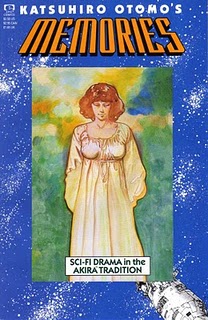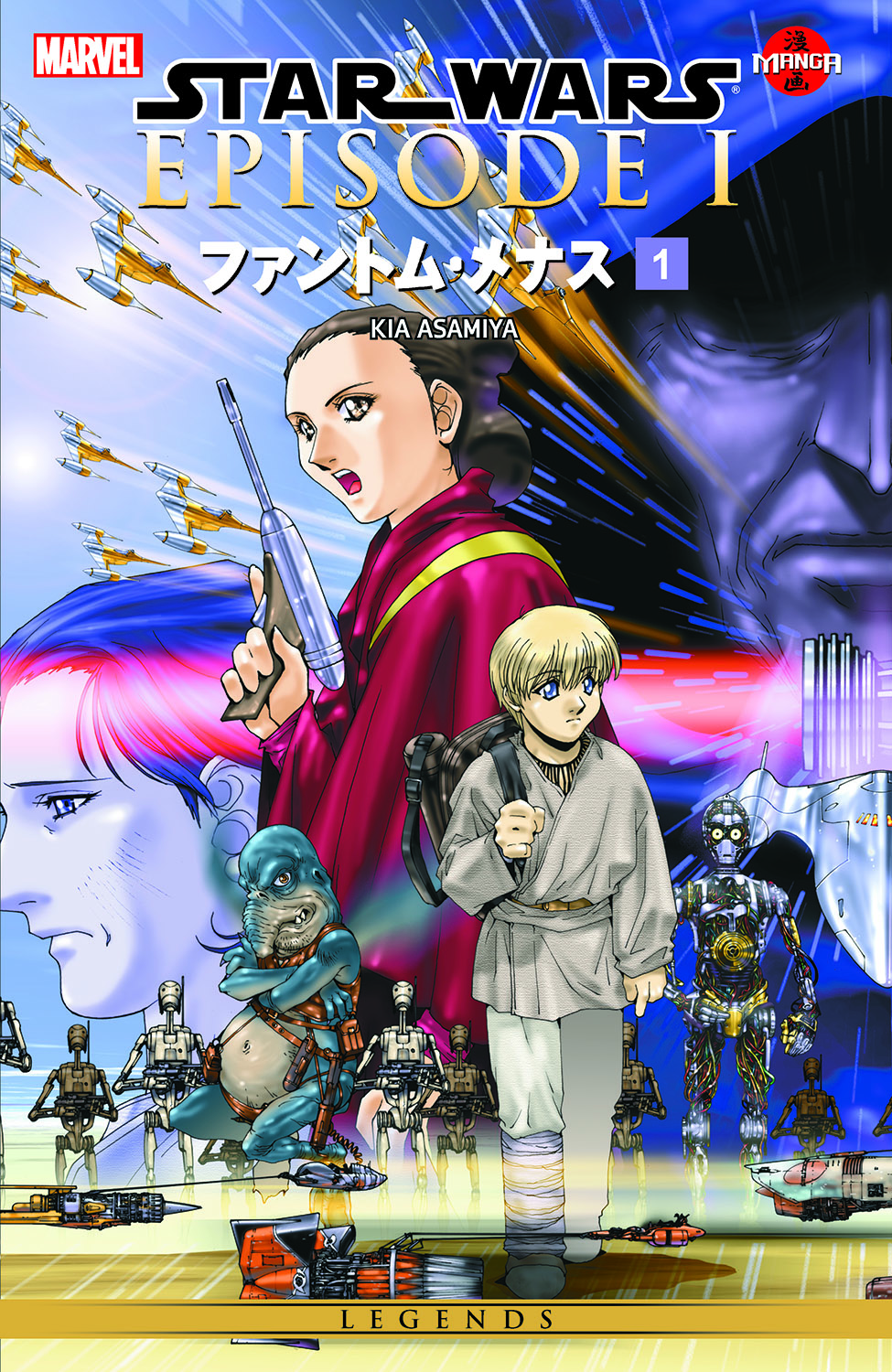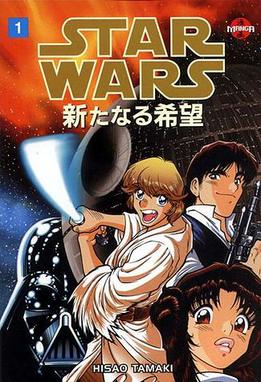Given the speed with which DC Comics shuttered CMX Manga last year, it’s easy to forget that both DC and Marvel actually wanted to publish manga back in the day. Marvel’s manga output paled in comparison with DC’s, but is notable nonetheless, as Marvel helped introduce American readers to one the most influential manga-ka of the last thirty years: Katsuhiro Otomo. Like Dark Horse, Eclipse Comics, and other companies who dabbled in manga publishing in the 1980s and 1990s, Marvel licensed work that it believed would appeal to the direct market. Marvel’s first acquisition was Katsuhiro Otomo’s dystopian epic AKIRA. Between 1988 and 1995, Marvel published the story in thirty-eight issues, each colorized and flipped in a calculated bid to woo American sci-fi fans. Though Marvel never finished collecting the original issues into bound editions, AKIRA proved important nonetheless, offering many American readers their first exposure to Japanese comics.
Marvel licensed work from other countries as well — including Airtight Garage and Blueberry, both by French artist Moebius — but never developed a substantial manga catalog; aside from AKIRA, the only manga it published were two short, stand-alone stories from early in Otomo’s career: “Memories” and “Farewell to Weapons.” “Memories” was issued in two forms: the first, in 1992, was a standard, thirty-two-page pamphlet with flipped, colorized artwork. The second, in 1995, was only released in the UK; Mandarin Books re-printed “Memories” and “Farewell to Weapons” as part of a longer anthology of Otomo’s short stories. (That anthology is called Memories and is out-of print; the ISBN is 0749396873.)
Plot-wise, “Memories” is simple but effective: a three-man salvage crew accepts a job clearing the “Sargasso Sea,” a debris field in deep space. They begin receiving a mysterious transmission from a large, rose-shaped ship inside the field, and decide to investigate. Once aboard, the crew makes an astonishing discovery: the interior resembles an English manor house with a formal dining room, an immense library, and a mysterious hallway guarded by robot sentries. As the men begin searching the ship for clues to the owner’s identity, a constellation of forces — including a fierce magnetic storm — threaten to compromise their mission.
It’s a tried-and-true sci-fi plot that’s enlivened by the efficiency of the set-up and the specificity of the art. Otomo wastes few pages establishing the crew members’ personalities and reasons for accepting the assignment. Though he teases the reader with hints about what awaits the men aboard the ghost ship, Otomo doesn’t belabor the introduction, swiftly transferring the action from the salvage vessel to the “magnetic rose.” The contrast between the ships is arresting; the Disposer is cramped, with plain steel walls and banks of computers, while the ghost ship is opulent and cavernous, festooned in elk heads, gilt-framed oil paintings, mirrors, and the kind of expensive bric-a-brac one might expect to find at Thornfield or Chesney Wold.
Normally, I’m a purist about black-and-white imagery, but Steve Oliff’s expert coloring brings clarity and emotion to the work that might otherwise be absent. Many of Otomo’s finer details — the pattern in an elaborate rug, for example, or the grain in a wood panel — pop with the judicious use of color, giving the ghost ship’s interior a more palpable feel. The use of rich reds, purples, and golds colors further reinforces strangeness of the environment; we, too, want to know why this lavish ship is adrift inside a cloud of metal, glass, and machine parts. Most importantly, however, Oliff uses color to underscore the characters’ emotional state, using an intense, disturbing green backdrop in the final pages of the story to suggest their growing state of panic as they discover the ship’s true purpose.
Readers curious about “Memories” won’t have any difficulty scaring up inexpensive copies on eBay; I paid less than a dollar for a bagged and boarded one in great condition. Anime fans may prefer to seek out the big-screen adaptation, which is longer and more detailed than the source material. (More information about the anime can be found here.) In either format, this short story is surprisingly eerie and graceful, proof that even the most familiar plot lines can acquire new power in the hands of an expert storyteller.
Manga Artifacts is a monthly feature exploring older, out-of-print manga published in the 1980s and 1990s. For a fuller description of the series’ purpose, see the inaugural column.
MEMORIES • BY KATSUHIRO OTOMO • EPIC COMICS (MARVEL) • 32 pp. • NO RATING




Melinda Beasi says:
Oh, how wonderful! Your Manga Artifacts column is one of my very favorites, and this article is a great example of why. I never knew this series existed, or about any of that history with Marvel and manga, actually. Thanks for this!
Katherine Dacey says:
Thanks, Melinda! I know this history is familiar to long-time manga fans, but as someone who didn’t discover manga until the mid-2000s, the 1980s and 1990s are new to me. I’ve had a lot of fun tracking down information on these older series; I just wish I’d been able to find some artwork from Memories, as I think it’s one of the story’s real selling points.
Jade Harris says:
I was able to dig up a copy of Memories in a quarter bin way back when you could still get quarter bin comics for a quarter. It’s a pretty solid find since there’s so little of Otomo manga available in English for how famous he is. It’s too bad more anthologies don’t get releases, Tezuka did a ton of short stories too.
Katherine Dacey says:
I second that motion! I would love to see Tezuka’s Crater licensed. Three volumes of short, experimental stories by Tezuka in a variety of genres? Yes, please!
Jade Harris says:
Right, I have a volume of that series and I’d love to be able to read it someday, haha.
Katherine Dacey says:
I’ve been contemplating buying Crater through a Japanese bookseller who has an eBay storefront. I own several other Japanese editions of Tezuka works — Ludwig B. and Faust among them — but since I can’t read them, it’s probably better to save my pennies for something I *can* read!
Kris says:
Oh, they did an animation for this!
Katsuhiro Otomo Presents: Memories
It’s a small sort of anthology, similar to Animatrix, and featured that very story about the spaceship with the ghostly manor house. It’s a really nice little DVD featuring Koji Morimoto, Tensai Okamuro, Katsuhiro Ôtomo, and Satoshi Kon.
Kris says:
Oh, I’m dumb. You did mention the anime. I skipped the last couple paragraphs in my excitement, lol.
Katherine Dacey says:
You make the anime sound a lot more exciting than I do, however, so thank you for the extra information about it!
Ian S says:
The Epic pamphlet version of Memories is just one small part of a much larger (250+ pages, large format – same size as the Akira books) anthology of Otomo’s short stories. It was published in English in the UK (by Mandarin) and, if memory serves, in Australia (by Random House Australia). It’s flipped but the vast majority of the stories are in black and white (or, in one instance, was in colour in the Japanese original) and the paper and printing quality is obviously a great deal better.
It’s long out of print and not particularly cheap – seems to fluctuate between £10.00 and £25.00 for a good used copy on amazon.co.uk – but is well worth picking up. I mean, it never approaches the level of Domu or Akira but that’s because they’re spectacular rather than because Memories is bad.
If anybody’s desperate for the bite size Epic version, Mile High Comics have it for as little as $1.00 (and even an as-new copy will only set you back $1.75) but if you can stomach the cost, the UK version really is infinitely preferable.
Katherine Dacey says:
Thanks for the tips, Ian! Your comments prompted me to investigate the Amazon UK site. I didn’t immediately spot the English-language edition of the Otomo anthology, but I did spot a French edition that was published in 2008. It’s in print and retailing for about £14.00 (about $23), offering folks another way to enjoy these stories.
I’m going to consult WorldCat to see if I can get the ISBN for the English anthology; if I can track it down, I’ll post it here.
Again, thanks for the information, Ian!
Ian S says:
Sorry – I didn’t think to add the ISBN numbers. Here they are:
# ISBN-10: 0749396873
# ISBN-13: 978-0749396879
The cheapest copy on amazon.co.uk is £20.00 but I’ve seen it go for a fair bit less so it’s worth keeping an eye on.
Katherine Dacey says:
Terrific — thanks for the information! I did a little digging, and it turns out Marvel published one other Otomo story here in the US, “Farewell to Weapons,” so I’ve incorporated that information plus the information about the Otomo anthology into the article.
I’ll definitely be monitoring Amazon UK — the cheapest copies on the US site are going for about $50 right now.
Ian S says:
No problem. I forgot to mention that anybody interested in digging up more early English language manga releases (which are often surprisingly affordable) could do a lot worse than checking out the “Early Manga Days: A Chronology” post over on Same Hat (http://samehat.blogspot.com/2010/02/early-manga-days-chronology.html).
I think it’s maybe missing one or two obscure releases but it’s a goldmine of information, especially regarding short manga stories that appeared in American anthology magazines and comics such as Imagine, RAW, Cheval Noir and Heavy Metal (not to mention more Marvel manga in the pages of their Epic Illustrated magazine).
Happy hunting!
Katherine Dacey says:
Glad you mentioned that resource, Ian — it’s one of my go-to sources when I’m doing the research for a Manga Artifacts column!
Jacob Slemmer says:
I discovered this awesome work a couple days ago while flipping through a box of comics in Buena Park, California (dollarbookfair.com) I was looking for a new series my 8 year old brother might be interested in, and this intrigued me so much upon reading it that I didn’t get around to finding something I thought would actually interest him. Sometimes when we’re attempting to help others we end up helping ourselves! This is the first ‘manga’ I’ve ever read, and I’m still yet to look up a definition of the word; but as the about section of this site perfectly states, “I’ve created this site for people like me, who identify themselves as readers above all else — people who are less concerned with being manga fans than in enjoying manga and discussing it with other smart folks.”
Katherine Dacey says:
Hi, Jacob! Nice to see people are still finding this post!
Since you enjoyed “Memories,” I’d encourage you to look for Memories, an anthology of short stories by the same author. (See discussion thread above for the ISBN.) The book was never released in the US (it was distributed in Australia and the UK only, I think), but it’s a great addition to any reader’s library. The stories run the gamut from short and experimental to grandly weird, but they’re some of my very favorite comics, period. I paid about $25 for a used copy in good condition at Amazon.
If you don’t want to spend that much money, you might search eBay (or comic store remainder bins) for “Farewell to Weapons,” another short story by Otomo. Like “Memories,” it was published by Marvel/Epic, and usually sells for about $1.00 – $5.00, depending on the condition.